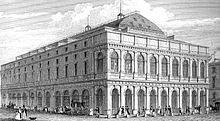Théâtre de la Renaissance
The first company to be called Théâtre de la Renaissance opened its doors in 1838 under the sponsorship of Victor Hugo and Alexandre Dumas, père, who wanted to have a location for mounting their historical dramas.[2] In April 1839, L'Alchimiste and Paul Jones by Alexandre Dumas (also with Frédérick Lemaître) were staged, but, due to theatrical intrigues, the theatre was forced to close in 1841.Thérèse Raquin (after the novel by Émile Zola) was premiered in July 1873, Giroflé-Girofla and La petite mariée, opéras-bouffes by Charles Lecocq in 1874 and 1875.[citation needed] In 1942, while the theatre was threatened with destruction, Henri Varna acquired the building and Jean Darcante put on shows.In 1990 La Cuisse du Steward by Jean-Michel Ribes was premiered, and in 1994 Un Air de Famille by Agnès Jaoui and Jean-Pierre Bacri.


Theatre de la RenaissanceSalle Ventadour2nd arrondissementPorte Saint-Martin10th arrondissementFeydeauVictorien SardouSarah BernhardtEleonora DuseAgnès JaouiJean-Pierre BacriVictor HugoAlexandre Dumas, pèreOpéra-ComiqueRuy BlasFrédérick LemaîtreDonizettiLucia di LammermoorLucie de LammermoorL'ange de NisidaLa favoriteAlexandre DumasCarvalhoThéâtre LyriqueVentadourAdolphe DeloffreThérèse RaquinÉmile ZolaGiroflé-GiroflaLa petite mariéeCharles LecocqVictor Koningopéras-bouffesopéras-comiquesJohann StraussLe petit ducBelle LuretteJacques OffenbachIsolineAndré MessagerMadame ChrysanthèmeGismondaLa Princesse LointaineEdmond RostandMaurice DonnayLa Ville morteGabriele d'AnnunzioRomain CoolusLorenzaccioMussetLucien GuitryJean DarcanteVéra KorèneComédie-FrançaiseSecond EmpireJean-Paul SartreSerge ReggianiFélicien MarceauArlettyMarcel AyméQui a peur de Virginia Woolf ?Jean PoiretopérettesWalsh TJ